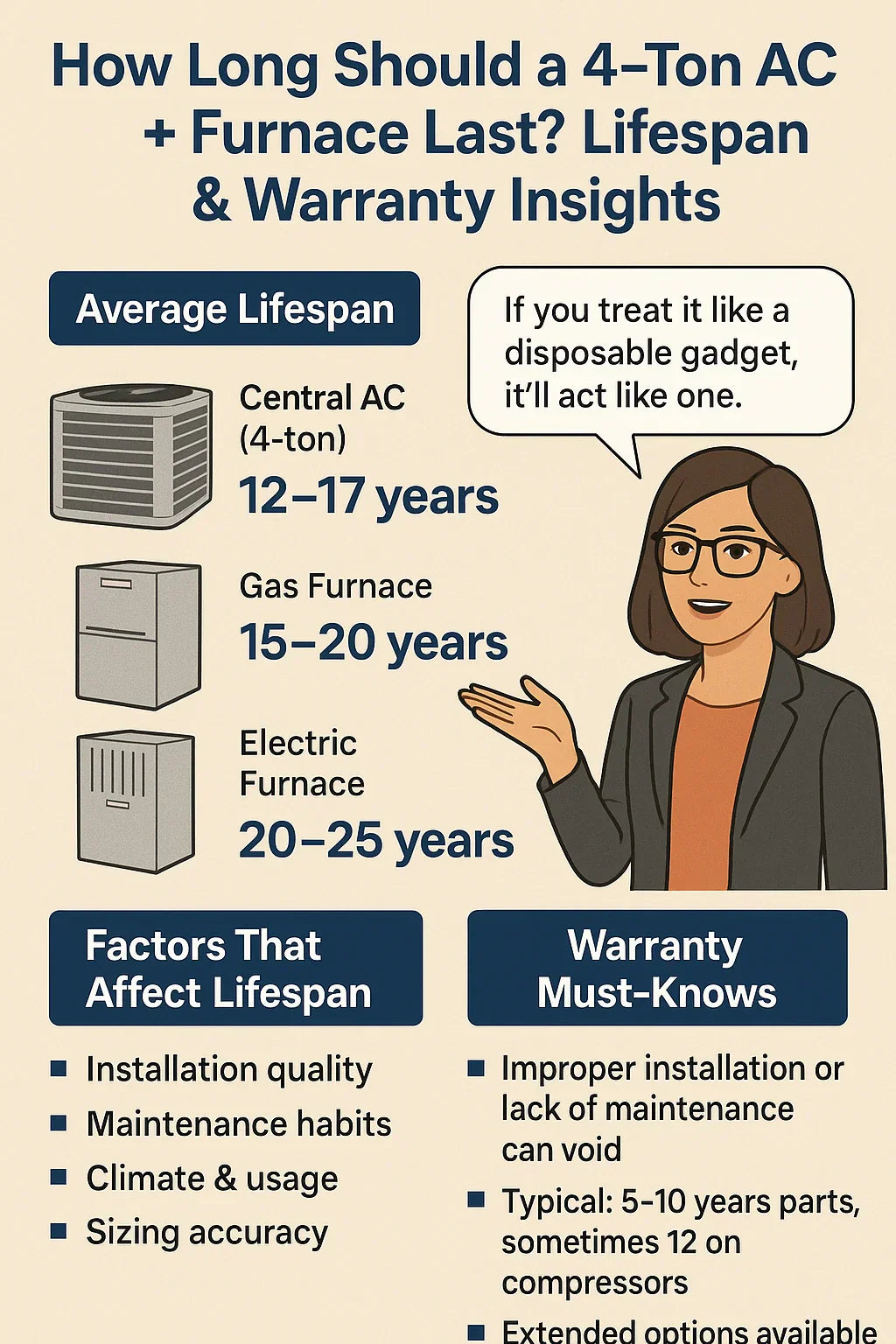1. Introduction – The Lifespan Question
Hey, it’s Savvy.
When I visit homes to help with HVAC decisions, one of the first questions I hear is:
“So, how long will this thing last?”
It’s a fair question. A 4-ton AC + furnace system is a big investment — one that can cost as much as a small car. And just like a car, how you treat it determines how many “miles” you’ll get.
I’ve seen well-maintained systems keep homes comfy for 20 years or more. I’ve also seen systems wheezing along after just 7 years because of poor installation, lack of maintenance, or just being the wrong size from day one.
In this guide, we’ll cover:
-
Average lifespan of a 4-ton AC and furnace
-
Factors that shorten or extend life
-
Warning signs your system is on its last legs
-
Warranty truths (and myths) you need to know
-
Savvy tips to get every last year out of your investment
2. Average Lifespan of a 4-Ton AC + Furnace
Lifespan isn’t a magic number — it’s a range. Here’s what’s typical in North America:
| Component | Average Lifespan | With Excellent Maintenance |
|---|---|---|
| Central AC (4-ton) | 12–17 years | 18–20 years |
| Gas Furnace | 15–20 years | 20–25 years |
| Electric Furnace | 20–25 years | 25+ years |
| Heat Pump (if paired instead of AC) | 10–15 years | 16–18 years |
Why the range?
-
Climate: Hot, humid regions wear out AC faster.
-
Usage: A system in Minnesota runs heat more, in Texas runs cooling more.
-
Maintenance: Neglect can cut lifespan by 30% or more.
3. Factors That Affect Longevity
1. Installation Quality
The most overlooked factor. Even the best equipment can fail early if installed poorly.
-
Incorrect refrigerant charge can kill a compressor.
-
Poor ductwork design can strain motors.
Savvy Tip: Always hire licensed installers with strong local reviews and proof of training.
2. Maintenance Habits
Skipping seasonal tune-ups or filter changes is like never changing the oil in your car.
-
Dirty coils make the AC work harder.
-
Blocked airflow overheats the furnace.
3. Climate & Usage
-
Desert heat = more AC runtime, faster wear.
-
Northern winters = more furnace cycles.
If you live where both extremes happen? You’ll stress both systems equally.
4. Sizing Accuracy
Oversized units short-cycle, which:
-
Wastes energy
-
Increases wear on compressors and heat exchangers
A proper Manual J calculation during install prevents this.
4. Warning Signs Your System Is Nearing End-of-Life
You don’t want to be surprised by a complete system failure in the middle of July or January. Look for these clues:
-
Frequent Repairs: If you’re calling your HVAC tech more than twice a year, it’s a red flag.
-
Rising Energy Bills: Efficiency drops as components wear out.
-
Uneven Comfort: Some rooms too hot, others too cold.
-
Excessive Noise: Grinding, banging, or rattling that wasn’t there before.
-
Age: If your AC is 15+ years or furnace is 20+, start planning for replacement.
5. How to Extend the Life of Your System
Here’s how to squeeze the most years out of your HVAC investment:
1. Seasonal Tune-Ups
-
Spring: AC check-up
-
Fall: Furnace check-up
2. Regular Filter Changes
-
Every 1–3 months, depending on filter type and home conditions.
3. Address Repairs Quickly
-
Small issues can turn into major failures if ignored.
4. Keep Outdoor Unit Clear
-
Maintain at least 2 feet of clearance all around.
5. Maintain Proper Humidity
-
High indoor humidity strains AC; too low can stress furnace parts.
6. Warranty Insights
Not all warranties are created equal.
Manufacturer Warranties
-
Parts Coverage: Typically 5–10 years for parts, 10–12 years for compressors.
-
Registration Required: Many brands require you to register within 60–90 days to get full coverage.
Labor Warranties
-
Provided by the installer, usually 1–2 years.
-
Covers the cost of work, not the parts.
Extended Warranties
-
Often offered by manufacturers or third parties.
-
Can extend coverage to 10–12 years labor & parts.
7. What Warranties Don’t Cover
This is the fine print most homeowners miss:
-
Improper Installation: If a licensed pro didn’t install it, coverage may be void.
-
Lack of Maintenance: Skipping annual service visits can cancel coverage.
-
Acts of Nature: Flooding, lightning, earthquakes.
-
DIY Repairs: If you tinker with refrigerant or wiring, warranty is gone.
8. Savvy’s Lifespan Case Studies
Case 1 – Well-Maintained System
-
4-ton AC in Florida, 15 years old.
-
Owner changed filters monthly and had twice-yearly tune-ups.
-
Still running at 90% efficiency.
Case 2 – Neglected System
-
4-ton AC in same climate, 8 years old.
-
Filter changed once a year (maybe).
-
Coil frozen, compressor failed — replacement required.
9. Planning for Replacement
The smartest homeowners start planning before a breakdown.
-
Budget Ahead: A 4-ton AC + furnace replacement runs $8,000–$14,000 installed.
-
Energy Savings: New systems can cut bills by 20–40%.
-
Off-Season Discounts: Install in spring or fall for better deals.
10. Savvy’s Takeaway
-
Expect 12–17 years from your AC and 15–20 years from your furnace.
-
With top-notch installation and care, you can push those numbers higher.
-
Warranties help, but they’re not a magic shield — read the fine print.
12. External Verified Sources
In the Next topic we will read more about: Tax Credits, Rebates & Incentives for 4-Ton AC + Furnace Systems in 2025







